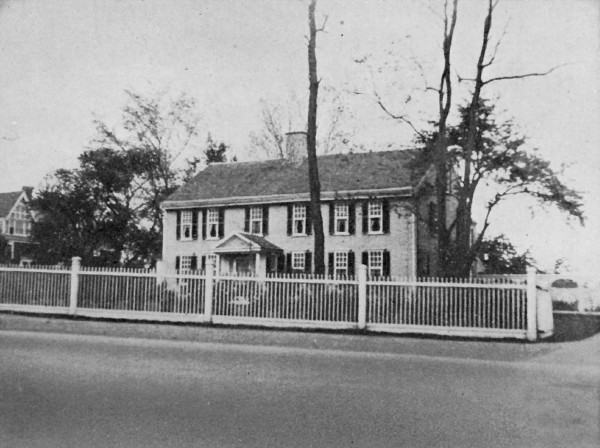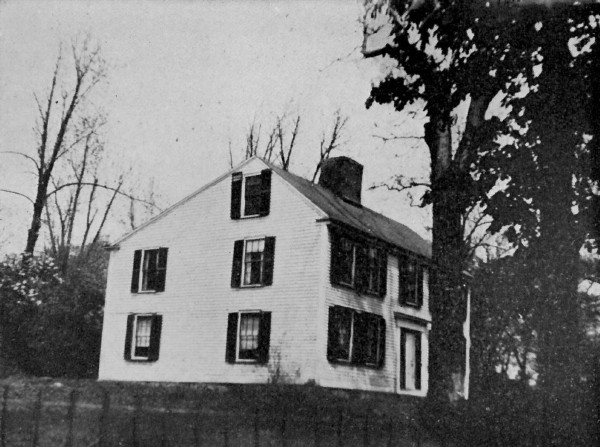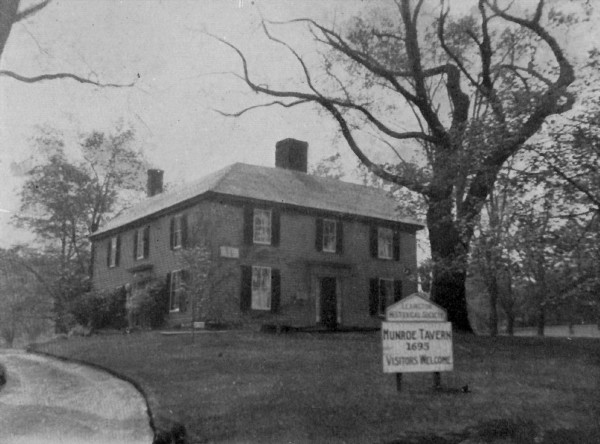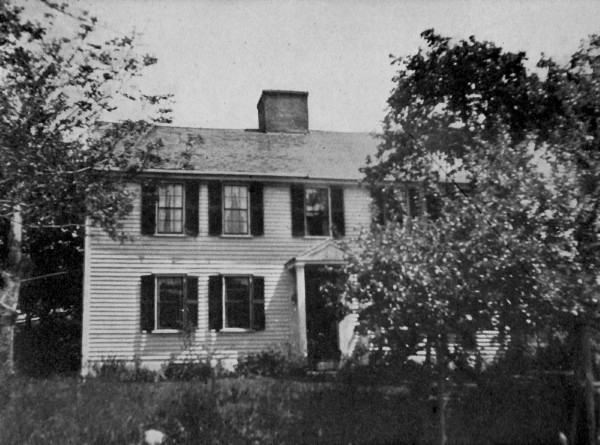| Web
and Book design,
Copyright, Kellscraft Studio 1999-2012 (Return to Web Text-ures) |
 (HOME)
|
| CHAPTER
III
GETTING DOWN TO BRASS TACKS HAVING sold myself thoroughly on this type of house, the next question was, "Is it practical?" "Can I have twentieth century conveniences in an eighteenth century setting?" History tells us there wasn't a bathtub in America until the time of the Revolution. And yet I wanted a bathroom. It also tells us that there were no forks, either, until John Quincy Adams brought them from France, but I have always felt that it is dangerous to eat with a knife, especially peas. A fireplace and a warming pan are nice to look at, but a furnace in the cellar isn't such a bad sight either on a zero morning. No one can claim any novelty for building a Colonial house to-day. But there is a difference between a Colonial house and an early New England farm-house. Houses of this latter type are far from common because people stop short of doing a complete job. They compromise with parquet floors, plate glass windows, porches and bay windows. You can't have a period house with these embellishments, any more than you can have a successful swimming pool if you insist upon keeping a pet man-eating shark in it. No matter what kind of a house you may build, your friends will be expected to rave about it. They always do this, no matter what they may secretly think. Like a new baby, we must say nice things even if we do have secret misgivings that its mother may have been too close a student of the comic strips before it was born. But after all, it isn't what other people think that really matters. It's what you think. Does your house satisfy you, or are you beginning to figure on the chance of building another even before you have successfully placed the second mortgage on the one you have? A visiting Englishman, an architect, once said that he considered a true Colonial house to be the only type fit for an American gentleman to live in. ''Yeah? is that so?" I can hear someone say from the depths of one of those concrete block and paper-shingled affairs that, to them, should be the pride and joy of their village street. Well, don't pick on me. I didn't say it. It is merely what this visiting Englishman said just before he sailed for home. He may have been as wrong as Charles Dickens, who, after he had been wined and dined in America, went home to write "American Sketches," which gives this land of the free a dirty dig on every other page. There must be some adequate come-back to what the English architect said, however. But don't expect it from me. So that's that. I once knew a man who inherited a lot of money and straightway built a mansion. A celebrated architect designed it. A firm of America's most famous interior decorators furnished it. They even bought pictures, china and rugs for him. His job was merely to pay the bills. It resulted in the stiffest and most unhome-like home I was ever in. The whole place seemed to be a "keep off the grass" sign. The bedrooms were so formal that one almost expected to be barred out by a big velvet rope like those in department stores and church weddings. The man who built this mansion was born and raised in a house that was two hundred years old. It nestled in a little valley surrounded by apple trees. The mansion required that the old house be torn down. The fireplace with its Dutch oven and crane had been the scene of many happy parties. Many a buckwheat cake was baked, many a hot apple toddy was brewed there before this new wealth enabled my friend to acquire a new point of view and an expensive stomach that required bismuth meals and frequent X-ray plates. The low ceilings and the batten doors and the sandstone door sill (of the house, not his stomach) would have been the joy of an antiquarian. The floors had been worn thin with the feet of many guests — some of them British officers quartered there after the Revolution. No one could blame a millionaire for wanting a better house. But why, in Heaven's name, did he not say to some architect, ''Here is a house that means home to me. Now preserve its spirit in a mansion." Are you asking me? I don't know. In an effort to do something unusual, people sometimes run wild when they build a house. Then they have a lot of time to repent, because trick houses are not only hard to sell but soon begin to look shabby. Trick houses affect values in a whole neighborhood. They are like dyspepsia. They make a lot of people suffer besides the patient. Our house happens to be located in a community where many second-growth chestnut trees had been killed by the blight which scourged the country twenty years ago. Recently a real estate developer conceived the idea that these second-growth chestnuts, long since dead on their feet, would make nice log cabins. And so it proved until he got "log-cabin phobia" and ran amuck. Fearing that some wisecracker may say, **Well he certainly went back to Colonial days for his inspiration," let me observe that our Puritan ancestors did not live in log cabins. They graduated from dugouts to houses. This man built dozens of log cabins of every size, shape and previous condition of servitude. He incorporated in them every combination of stucco, field stone and brick that he could contrive. It resulted in a veritable hodge-podge of bootleg architecture — Spanish doorways, flamboyant French grilles, Japanese casements, English clustered chimneys, Dutch gambrel roofs — all basically log cabins but roofed with paper shingles more brilliant than Joseph's coat and entirely unrecognizable as log cabins from the standpoint of Daniel Boone. When I planked a New England farm-house in this setting, it was almost cheating. Total strangers have asked permission to go through the house. They say it looks restful or that they want to build one like it or something. Some day, perhaps, a stranger will hit a member of my family over the head with a piece of lead pipe, and rob us, but up to now we have had welcome on the mat for everyone except a man soliciting contributions for the Anti-Saloon League and a suffering Armenian who was selling rugs to pay his way through a Methodist college. It seems natural for Americans to like old fashioned houses and furniture, even if they are content to have their own homes furnished with Mission chairs, Brussels carpets and mail-order plush parlor suits. Liking antiques and getting them are horses of different colors. It takes a persistent fish to swim against the current of modernism, but no matter how hard he swims, he never sweats.
  These Houses are at least 225 years old.   Two more Houses that date back to 1700.
As a rule, people don't naturally like things merely because they are old. That is an acquired taste. We can look with perfect calm on the gilt and tinsel furniture of the Louies of France and gaze on the corrupting influence of Napoleon in the so-called Empire period, that sent the delicate creations of Chippendale and Sheraton to the woodshed. But just show an average American some old batten door that says, ''Sure I used to be hanging around here when Paul Revere made his ride." Let him see a staircase with its delicate ramps and spindles, its worn treads that creaked the arrival of the Elk or Rotarian of 1700, returning from an evening sitting up with a sick horse, and he is immediately interested. Early houses were comfortable houses. The colonists never went in for narrow slits of windows, or great expanses of dead wall that an architect tells you is early Tudor, while the family inside play that they are in jail. One of the main requirements of any house should be lots of daylight. That means lots of windows. No matter what type of house you build, don't pay too much attention to what people tell you. There is no occupation that harbors more kibitzers than amateur house-building. Mrs. Jones will say to your wife, "Of course you don't intend to have those little window panes. They are so hard to wash." And Mrs. Fortesque will chime in with her five cents' worth about 'low ceilings" or "a small kitchen." You almost feel like apologizing if such things happen to be your intention. One man saw my house shortly after the siding was on. I was glibly describing how a big chimney would shortly rear its head above the ridge. He gently but firmly threw a monkey-wrench into the bearings by the remark: "Don't do it. You will spoil the house." This was simply the criticism of a man who failed to have the slightest comprehension of what it was all about. He lived in a community where chimneys resembled toothpicks, most of them three bricks wide and covered with stucco. His idea of an early American house was probably a cabin where the colonists shot Indians through the chinks in the logs just as a setting up exercise before family prayers. But despite his warning I did not rip down the frame and begin all over, this time making it a combination Queen Anne cottage and Swiss chateau. Most people haven't much imagination anyway. Don't try to sell your house plans in advance. It is said that the best advertising is written to be understood by readers with a twelve-year-old intellect. That's too high a rating for anyone who helps to make "You're the cream in my coffee" a song hit. Surround your house with a little mystery. Let it speak for itself after it is finished. You can't describe a white picket fence with hollyhocks peeping over the top, any more than you can describe the taste of a vintage wine. In sticking to early American lines in your house, you can be reasonably sure of one thing. You will probably never get tired of it. Houses that were built in 1700 and are still attractive prove that they are something more than a passing fad. In spite of Thomas Jefferson, fads don't last 229 years and wind up going stronger than when they started. As a matter of fact, such houses never look new. Our oak plank floors were a hundred years old in appearance the day they were laid. Places where the painter skimped in his job only add to the effect of age — but don't encourage him in that. He will try to gyp you enough anyway. Stone walls properly laid are never new, especially if you can get stones from an old foundation. An early American house can stand looking a little weather-beaten. It is the modern type that soon gets a ''down in the heel" appearance. Modernism can't stand age. It is like your last year's straw hat. When a nifty stucco house loses its stucco, or the Mediterranean bungalow shows signs of wear in an eastern climate, it looks seedy. But your old central-chimney boy maintains his dignity and aloofness even when buffeting storms and blistering suns begin to demand their toll. A little missing paint, here and there, is like the dents in a pewter jug, or the patina of old mahogany. One period house I know of was deliberately made to look old by chipping off bits of brick here and there and hammering the woodwork in places. I wouldn't do that. It is too much like buying your fish and claiming that you caught them. Any house ages fast enough even with the best of care. There are millions of seven-room or eight-room, detached houses in America. This size seems to meet the standard requirements of the family of moderate means. It is on houses of this size that the blight of banality and hideousness has descended. Look at them out of your train window. See them on every side in the suburbs of a city. Watch them go up almost over night in some mushroom development. That is American architecture. There has been a distinct advance toward landscape gardening recently, to hide some of the defects of the houses, with trees and bushes. How grateful we feel when some thoughtful soul has relieved the bareness of his garage, for example, with a hedge or vine lattice. How you cheer when some intrepid soul rips off a front porch and paints the whole house white. How grateful his living room must also feel at the first glimpse of sunshine in thirty years. Houses all alike would be deadly monotonous. But there is little danger of that happening with early American types of houses. There are mid-west cities of 100,000 population without a single one yet. We see many such houses in New England but we never complain of the monotony any more than we complain of the monotony of the fleecy clouds or of moonlight through the hemlock branches. It is to avoid monotony that some of the greatest architectural crimes have been committed. And now many people are on the threshold of going back two hundred years for their inspiration. The present vogue for sunshine will undoubtedly demand houses without those gloomy room-darkening porches. It has got to be one or the other — sunny windows or porches. As Al Smith said so often in the presidential campaign, "You can't have it both ways." Now we have glass that admits the ultra-violet rays to give us health. Now we can secure a beautiful coat of tan in the drug store. We are surely going back to sunshiny houses. Winter is the time when sunlight is most appreciated. But in locating your house, remember one thing. Contrary to your geography, the sun doesn't rise in the East and set in the West in winter when you want it the most. It rides far south of East and West and requires windows almost facing South to get a maximum amount of sunshine. In the old days, houses were frequently located by the points of compass. The main road bore but little relation to the house. A curving lane took care of that. I once owned a house where the kitchen got gorgeous sunshine all winter. The living room was as dark as a tomb. If the house could have been turned half way around it would have been fine. As it was, I sold the house. If you really would like an early American home, most architects would be delighted with a commission to design it. People who have an ideal like that are scarce. The architect would doubtless suggest many improvements to my house. Don't cramp his style. Don't suggest impossibilities like big window panes or a nice bay window. Go the whole hog, plank floors, rim locks on your doors, arches, built-in cupboards and every thin'. You can find much material, especially millwork and hardware, readily available in true authentic reproduction. It is even easier to get these things than modern material. And the cost is no greater. In planning any house remember it is size more than shape that costs money. That is one argument in favor of the house I am describing. Every available foot of space is utilized. It is possible to figure the cost of a simple house merely by figuring the cubical contents and multiplying it by a fixed cost per cubic foot. Such calculations must take into account the local cost of labor and material, but a local contractor can help you with that if he has built many houses. Valleys and hips and dormers and gimcracks are what cost the money. Early houses of the particular type I built rarely had dormer windows. Modern reproductions sometimes preserved the old lines for the front and put a dormer or two in the rear. The Duxbury barn or shed-roof type of house is two stories in front and one in the rear. With this type there is no possibility of rear windows without dormers. The rear space on the second floor simply made a huge dark closet under the roof. That's where the patriots hid from the King's men. As there is no necessity of hiding patriots now except from prohibition enforcement officers, the full two-story house, both front and rear, seems to possess many advantages. One surprising thing has developed in our house. Almost everyone regards it as a large house. As a matter of fact, it is small as houses go. There are thousands of larger eight-room houses in every development. But our extensions and the big chimney undoubtedly add to the effect of size. Another thing that adds to this effect is our location on top of a hill with a river at the rear and a lake in front. We owned the lot, a tract of about an acre, for years before we built. It has gorgeous old trees, blueberries and wild laurel. It also has millions of rocks and the balance sand. As a garden site, it wasn't so good. As a home site, it was ideal. Perhaps if we hadn't owned this lot, we might have been living in Boston yet. But I doubt it. This is no reflection on Boston. I was born and raised in the shadow of New York. When I am away from home I invariably weep when the orchestra plays, "When you leave old New York town, you're only camping out." There are many things to like about New England. Its historic associations, its fine old trees, its shore drives, and, last but not least, its houses. Perhaps I was homesick for New Jersey's hills and brooks. I certainly wasn't permitted to become homesick for Jersey mosquitoes. There are more mosquitoes to the square inch in certain sections of the South Shore of Massachusetts Bay than any place I ever visited in New Jersey — and I have seen quite a few. But I felt somewhat about Boston as the chap who liked the opera except for the singing. That is how it came to pass that we restudied our photographs, made more measurements, completed our model, drew our plans and, with dogs and goods and chattels, left New England. In four days we had started the house in New Jersey. |